engine GMC SIERRA 1998 User Guide
[x] Cancel search | Manufacturer: GMC, Model Year: 1998, Model line: SIERRA, Model: GMC SIERRA 1998Pages: 452, PDF Size: 23.65 MB
Page 103 of 452
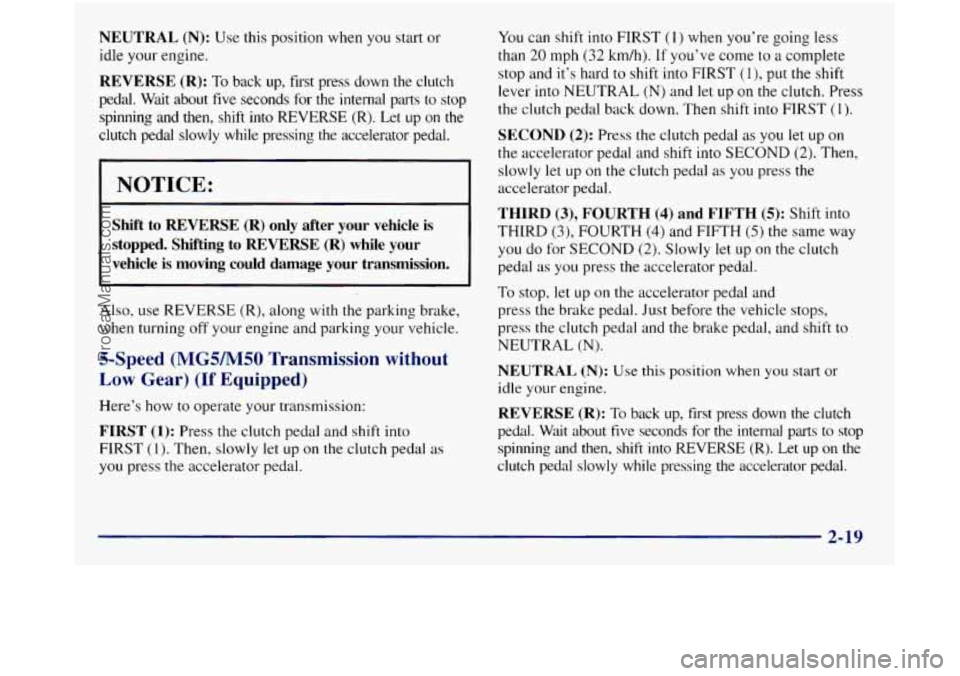
NEUTRAL (N): Use this position when you start or
idle your engine.
REVERSE (R): To back up, first press down the clutch
pedal. Wait about five seconds for the internal parts to stop
spinning and then, shift into REVERSE (R).
Let up on the
clutch pedal slowly while pressing the accelerator pedal.
I NOTICE:
Shift to REVERSE (R) only after your vehicle is
stopped. Shifting
to REVERSE (R) while your
vehicle is moving could damage
your transmission.
Also, use REVERSE (R), along with the parking brake,
when turning off your engine and parking your vehicle.
5-Speed (MG5M50 Transmission without
Low Gear) (If Equipped)
Here’s how to operate your transmission:
FIRST (1): Press the clutch pedal and shift into
FIRST
(1). Then, slowly let up on the clutch pedal as
you press the accelerator pedal. You
can shift into FIRST
(1) when you’re going less
than
20 mph (32 km/h). If you’ve come to a complete
stop and
it’s hard to shift into FIRST (l), put the shift
lever into NEUTRAL
(N) and let up on the clutch. Press
the clutch pedal back down. Then shift into FIRST
(I).
SECOND (2): Press the clutch pedal as you let up on
the accelerator pedal and shift into
SECOND (2). Then,
slowly let up on the clutch pedal
as you press the
accelerator pedal.
THIRD (3), FOURTH (4) and FIFTH (5): Shift into
THIRD
(3), FOURTH (4) and FIFTH (5) the same way
you do for SECOND (2). Slowly let up on the clutch
pedal
as you press the accelerator pedal.
To stop, let up on the accelerator pedal and
press the brake pedal. Just before the vehicle stops,
press the clutch pedal and the brake pedal, and shift to
NEUTRAL
(N).
NEUTRAL (N): Use this position when you start or
idle your engine.
REVERSE (R): To back up, first press down the clutch
pedal. Wait about five seconds
for the internal parts to stop
spinning and then, shift
into REVERSE (R). Let up on the
clutch pedal slowly while pressing the accelerator pedal.
2-19
ProCarManuals.com
Page 104 of 452

NOTICE:
Up Shift Light
4l
If you have a manual
Shift to REVERSE (R) only after your vehicle is transmission, you may have
a SHIFT light. This light
stopped. Shifting to REVERSE (R) while your
vehicle is moving could damage your transmission. will show you when to shift
best fuel economy.
to the next higher gear for
SHIFT
AI - - , use REVERSE (R), along with the parking brake,
when turning
off your engine and parking your vehicle.
Shift Speeds
I JOU skip more than one gear when you
downshift, you could lose control
of your vehicle.
And you could injure yourself or others. Don’t shift
down more than one gear when you downshift.
If your speed drops below 20 mph (32 kmh), or if the
engine
is not running smoothly, you should downshift to
the next lower gear. You may have to downshift two or
more gears to keep the engine running smoothly or for
good performance. When
this light comes on,
you can shift to the next
higher gear if weather, road and traffic conditions let
you. For the best fuel economy, accelerate slowly and
shift when the light comes on.
While
you accelerate, it is normal for the light to go on
and
off if you quickly change the position of the
accelerator. Ignore the
SHIFT light when you downshift.
If your vehicle has four-wheel drive and
is equipped
with a manual transmission, disregard the SHIFT light
when
the transfer case is in 4-Wheel Low.
I
2-20
ProCarManuals.com
Page 105 of 452
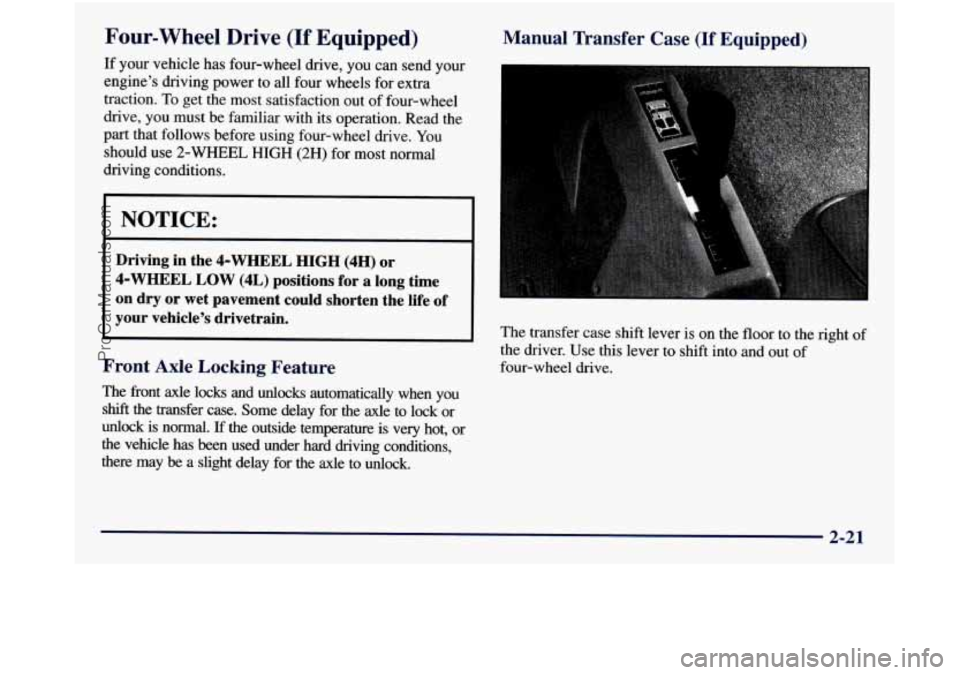
Four-wheel Drive (If Equipped)
If your vehicle has four-wheel drive, you can send your
engine’s driving power to all four wheels for
extra
traction. To get the most satisfaction out of four-wheel
drive, you must be familiar with its operation. Read the
part that follows before using four-wheel drive. You
should use
2-WHEEL HIGH (2H) for most normal
driving conditions.
I i
I NOTICE:
Driving in the 4-WHEEL HIGH (4H) or
4-WHEEL LOW (4L) positions for a long time
on dry or wet pavement could shorten the life
of
your vehicle’s drivetrain.
Front Axle Locking Feature
The front axle locks and unlocks automatically when you
shift the transfer case. Some delay for the axle to lock or
unlock is normal.
If the outside temperature is very hot, or
the vehicle has been used under hard driving conditions,
there may
be a slight delay for the axle to unlock.
Manual Transfer Case (If Equipped)
The transfer case shift lever is on the floor to the right of
the driver. Use this lever to shift into and out of
four-wheel drive.
2-21
ProCarManuals.com
Page 110 of 452
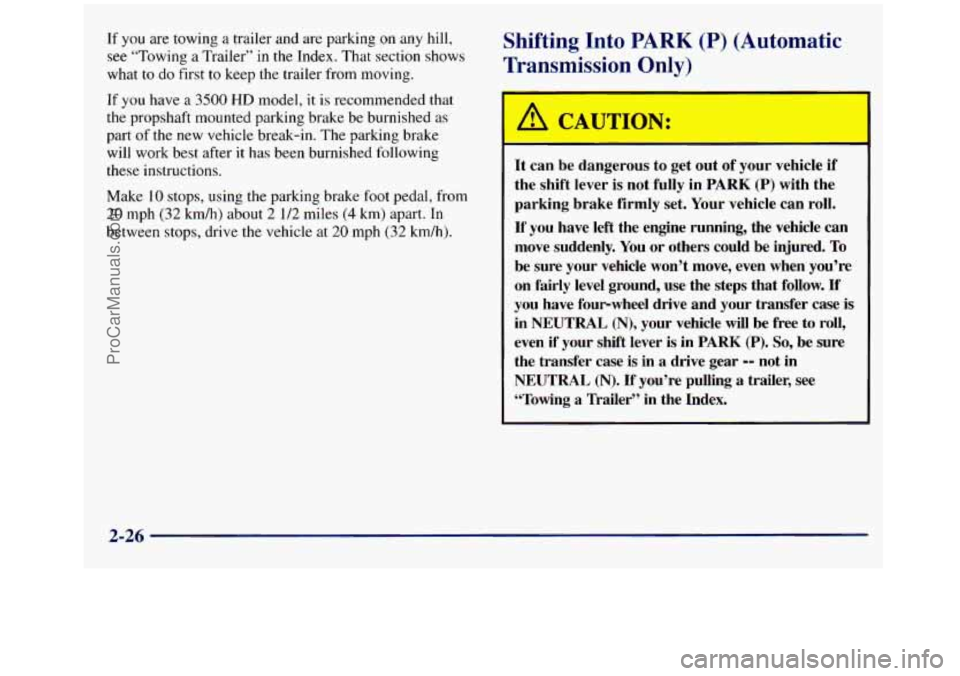
If you are towing a trailer and are parking on any hill,
see “Towing a Trailer” in the Index. That section shows
what to do first
to keep the trailer from moving.
Shifting Into PARK (P) (Automatic
Transmission Only)
If you have a 3500 HD model, it is recommended that
the propshaft mounted parking brake be burnished
as
part of the new vehicle break-in. The parking brake
will work best after
it has been burnished following
these instructions.
Make
10 stops, using the parking brake foot pedal, from
20 mph (32 kmh) about 2 1/2 miles (4 km) apart. In
between stops, drive the vehicle at
20 mph (32 km/h).
A CAUTION:
-
It can be dangerous to get out of your vehicle if
the shift lever is not fully in PARK (P) with the
parking brake firmly
set. Your vehicle can roll.
If you have left the engine running, the vehicle can
move suddenly. You
or others could be injured. To
be sure your vehicle won’t move, even when you’re
on fairly level ground, use the steps that follow.
If
you have fourwheel drive and your transfer case is
in
NEUTRAL (N), your vehicle will be free to roll,
even
if your shift lever is in PARK (P). So, be sure
the transfer case is in a drive gear
-- not in
NEUTRAL (N). If you’re pulling a trailer, see
“Towing a Trailer” in the Index.
2-26
ProCarManuals.com
Page 112 of 452

Leaving Your Vehicle With the Engine
Running (Automatic Transmission
Only)
I A CATJTION:
It can be dangerous to leave your vehicle with the
engine running. Your vehicle could move
suddenly if the shift lever
is not fully in PARK (P)
with the parking brake firmly set. If you have
four-wheel drive with
a manual transfer case
shift lever and your transfer case is in
NEUTRAL
(N), your vehicle will be free to roll,
even if your shift lever is in PARK
(P). So be sure
the transfer case is in
a drive gear -- not in
NEUTRAL
(N). And, if you leave the vehicle with
the engine running, it could overheat and even
catch fire.
You or others could be injured. Don’t
leave your vehicle with the engine running unless
you have to. If you
have to leave your vehicle with the engine
running, be sure your vehicle
is in PARK (P) and the
parking brake is firmly set before you leave it. After
you
move the shift lever into PARK (P), hold the regular
brake pedal down. Then, see if you can move the shift
lever away from PARK
(P) without first pulling it
toward you. If you can, it means that
the shift lever
wasn’t
fully locked into PARK (P).
Torque Lock (Automatic Transmission)
If you are parking on a hill and you don’t shift your
transmission into PARK (P) properly, the weight of the
vehicle may put
too much force on the parking pawl in
the transmission.
You may find it difficult to pull the
shift lever out of PARK
(P). This is called “torque lock.”
To prevent torque lock, set the parking brake and then
shift
into PARK (P) properly before you leave the
driver’s seat.
To find out how, see “Shifting Into
PARK
(P)” in the Index.
When
you are ready to drive, move the shift lever out of
PARK (P)
before you release the parking brake.
If torque lock does occur, you may need to have another
vehicle push yours a little uphill to take some
of the
pressure from the parking pawl in the transmission,
so
you can pull the shift lever out of PARK (P).
2-28
ProCarManuals.com
Page 113 of 452

Shifting Out of PARK (P)
(Automatic Transmission)
Your vehicle has a brake-transmission shift interlock
system. You have to fully apply your regular brakes
before you can shift from PARK
(P) when the ignition is
in
RUN. See “Automatic Transmission” in the Index.
If you cannot shift out of PARK
(P), ease pressure on
the shift lever and push the shift lever all the way up
into PARK
(P) as you maintain brake application. Then,
move the shift lever
to any gear you want.
If you ever hold the brake pedal down but still can’t
shift
out of PARK (P), try this:
1. Turn the key to OFF.
2. Apply and hold the brake until the end of Step 4.
3. Shift to NEUTRAL (N).
4. Start the vehicle and shift to the drive gear you want.
5. Have the brake-transmission shift interlock system
fixed as
soon as you can.
Parking Your Vehicle
(Manual Transmission Models
Only)
Before you get out of your vehicle, put your manual
transmission in REVERSE
(R), turn off the engine, and
firmly apply the parking brake.
If you have four-wheel drive, be sure your transfer case
is in a drive gear. Your vehicle could roll if it isn’t.
If
you are parking on a hill, or if you are pulling a
trailer, see “Towing a Trailer” in
the Index.
2-29
ProCarManuals.com
Page 114 of 452
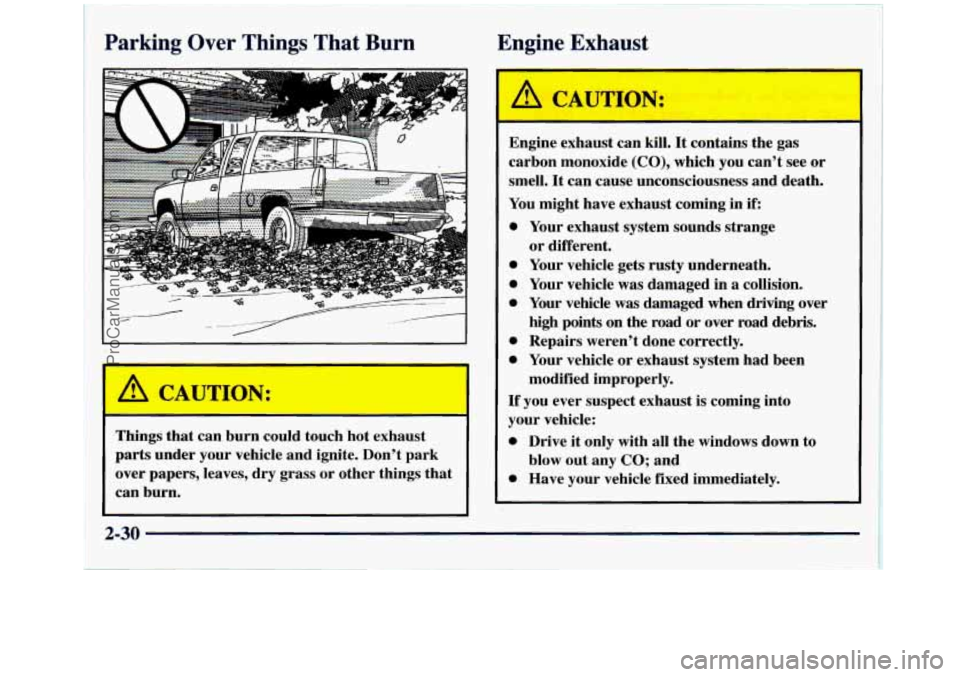
Pa ng Over Things That Burn
--
Things that can burn could touch hot exhaust
parts under your vehicle and ignite. Don’t park
over papers, leaves, dry grass or other things that
can burn.
Engine Exhaust
0
0
Engine exhaust can kill. It contains the gas
carbon monoxide
(CO), which you can’t see or
smell. It can cause unconsciousness and death.
You might have exhaust coming in
if:
Your exhaust system sounds strange
or different.
Your vehicle gets rusty underneath.
Your vehicle was damaged in
a collision.
Your vehicle
was damaged when driving over
high points on the road or over road debris.
Repairs weren’t done correctly.
Your vehicle or exhaust system had been
modified improperly.
If you ever suspect exhaust is coming into
your vehicle:
0 Drive it only with all the windows down to
0 Have your vehicle fixed immediately. blow out any
CO; and
2-30
ProCarManuals.com
Page 115 of 452
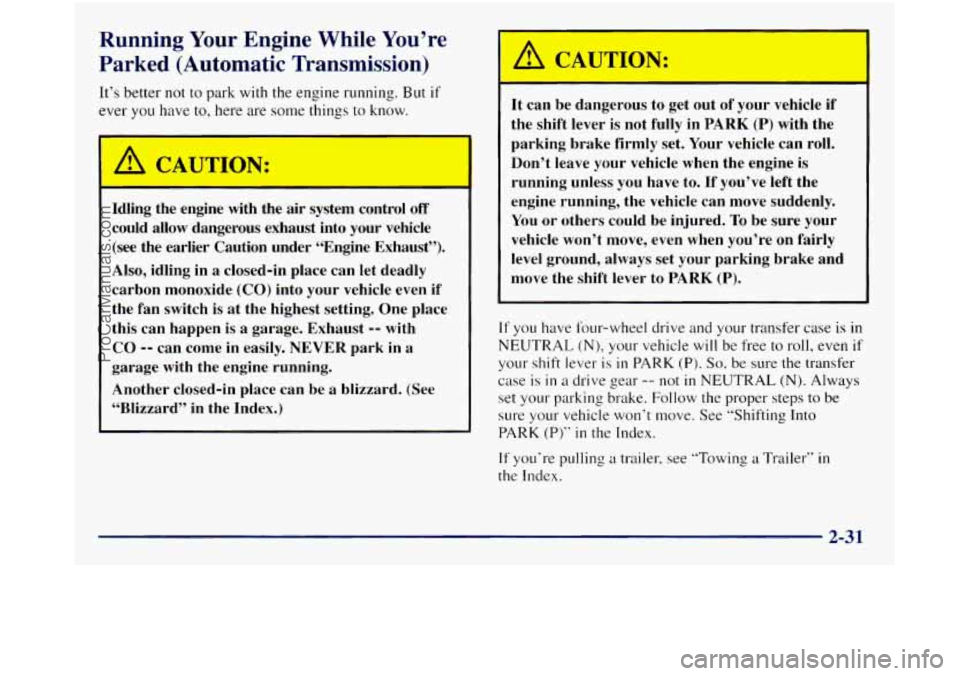
Running Your Engine While You’re
Parked (Automatic
1 ~ ission) an
It’s better not to park with the engme rblllling. But if
ever you have to, here are some things to know.
c
A A AUTION: -1
i Idling the engine with the air system control off
could allow dangerous exhaust into your vehicle
(see the earlier Caution under “Engine Exhaust”).
Also, idling in a closed-in place can let deadly
carbon monoxide
(CO) into your vehicle even if
the fan switch is at the highest setting. One place
this can happen is a garage. Exhaust
-- with
CO -- can come in easily. NEVER park in a
garage with the engine running.
Another closed-in place can be a blizzard. (See
“Blizzard” in the Index.)
4 CAUT- IN: -
It can be dangerous to get out of your vehicle if
the shift lever is not fully in
PARK (P) with the
parking brake firmly set. Your vehicle can
roll.
Don’t leave your vehicle when the engine is
running unless you have to. If you’ve left the
engine running, the vehicle can move suddenly.
You or others could be injured.
To be sure your
vehicle won’t move, even when you’re on fairly
level ground, always set your parking brake and
move the shift lever to
PARK (P).
If you have four-wheel drive and your transfer case is in
NEUTRAL (N), your vehicle will be free to roll, even if
your shift lever is in PARK (P). So. be sure the transfer
case is in a drive gear -- not in NEUTRAL (N). Always
set your parking brake. Follow the proper steps to be
sure your vehicle won’t move.
See ”Shifting Into
PARK
(P)” in the Index.
If you’re pulling a trailer. see “Towing a Trailer” in
the Index.
2-31
ProCarManuals.com
Page 147 of 452
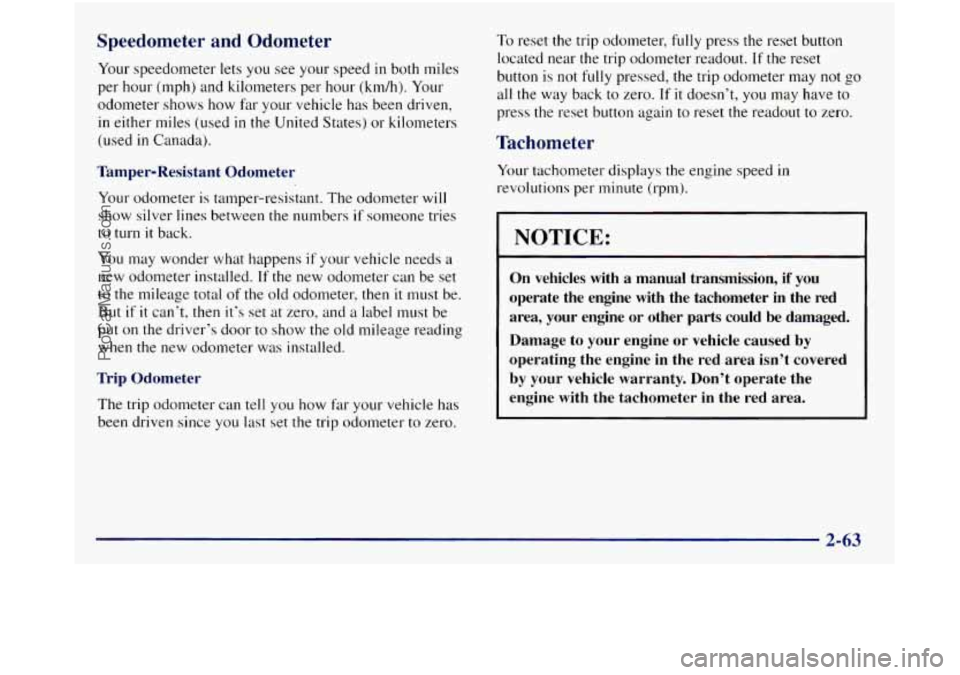
Speedometer and Odometer
Your speedometer lets you see your speed in both miles
per hour (mphj and kilometers per hour (km/hj. Your
odometer shows how far your vehicle has been driven,
in either miles (used
in the United States) or kilometers
(used
in Canada).
Tamper-Resistant Odometer
Your odometer is tamper-resistant. The odometer will
show silver lines between the numbers if someone tries
to turn it back.
You may wonder what happens if your vehicle needs a
new odometer installed. If the new odometer can be set
to the mileage total of
the old odometer, then it must be.
But if
it can’t, then it’s set at zero, and a label must be
put on the driver‘s door to show
the old mileage reading
when
the new odometer was installed.
Trip Odometer
The trip odometer can tell you how far your vehicle has
been driven since you last set the trip odometer to zero.
To reset the trip odometer, fully press the reset button
located near the trip odometer readout.
If the reset
button is not
fully pressed, the trip odometer may not go
all the way back to zero. If it doesn’t, you may have to
press the reset button again
to reset the readout to zero.
Tachometer
Your tachometer displays the engine speed in
revolutions per minute (rpmj.
NOTICE:
On vehicles with a manual transmission, if you
operate the engine with the tachometer in the red
area, your engine or other parts could be damaged.
Damage to your engine or vehicle caused by
operating the engine in the red area isn’t covered
by your vehicle warranty. Don’t operate the
engine with the tachometer in the red area.
2-63
ProCarManuals.com
Page 148 of 452
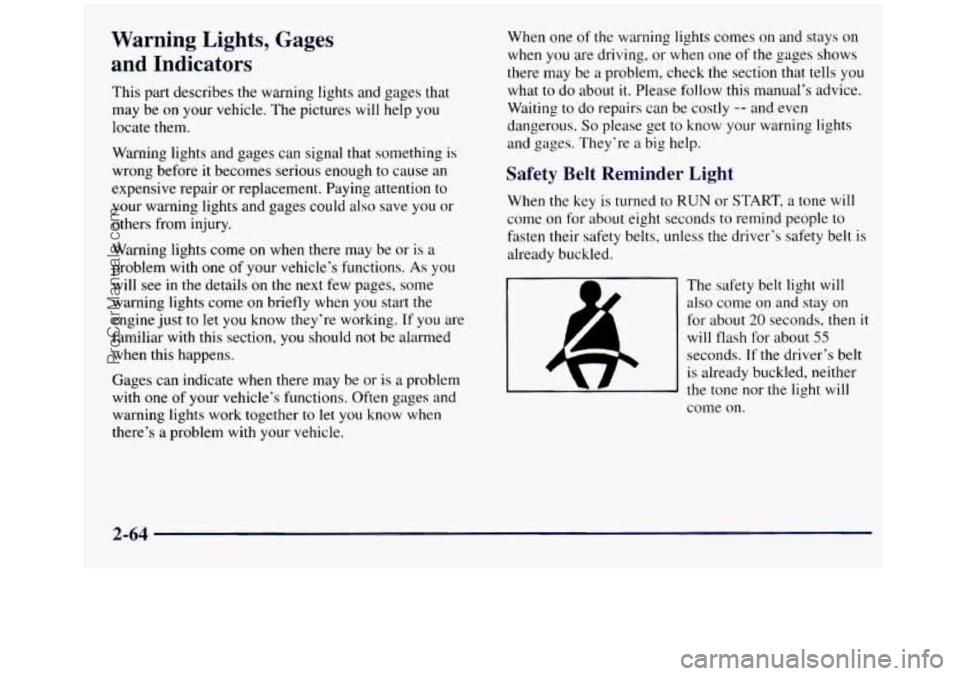
Warning Lights, Gages
and Indicators
This part describes the warning lights and gages that
may be on your vehicle. The pictures will help you
locate them.
Warning lights and gages can signal that something
is
wrong before it becomes serious enough to cause an
expensive repair or replacement. Paying attention to
your warning lights and gages could also save you or
others
from injury.
Warning lights come on when there
miiy be or is a
problem with
one of your vehicle’s functions. As you
will see
in the details on the next few pages, some
warning lights come on briefly when you start the
engine just to let you know they’re working.
If you are
familiar with this section, you should not be alarmed
when this happens.
Gages can indicate when there may be or is
a problem
with one
of your vehicle’s functions. Often gages and
warning lights work together to let you know when
there’s a problem with your vehicle. When
one
of the warning lights comes on and stays on
when you are driving, or when one
of the gages shows
there
may be a problem, check the section that tells you
what to
do about it. Please follow this manual’s advice.
Waiting to do repairs can be costly
-- and even
dangerous. So please get to know your warning lights
and gages. They’re
a big help.
Safety Belt Reminder Light
When the key is turned to RUN or START, a tone will
come
on for about eight seconds to remind people to
fasten their safety belts, unless the driver’s safety belt is
already buckled.
The safety belt light will
also come on and stay on
for about 20 seconds, then it
will flash for about 55
seconds. If the driver’s belt
is already buckled, neither
the tone nor the light will
come on.
2-64
ProCarManuals.com